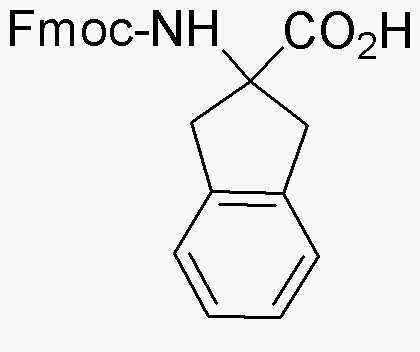Fmoc-2-aminoindane-2-carboxylic acid is widely utilized in research focused on:
- Peptide Synthesis: This compound serves as a key building block in the synthesis of peptides, particularly in solid-phase peptide synthesis (SPPS), allowing for the creation of complex peptide chains with high purity.
- Drug Development: Its unique structure aids in the design of novel pharmaceuticals, especially in developing compounds that target specific biological pathways, enhancing the efficacy of drug candidates.
- Bioconjugation: The chemical is used in bioconjugation processes, linking biomolecules for therapeutic applications, which is crucial in creating targeted drug delivery systems.
- Research in Neuroscience: This compound has applications in neuroscience research, particularly in studying receptor interactions and signaling pathways, contributing to advancements in understanding neurological disorders.
- Material Science: It is also explored in material science for developing functional materials with specific properties, such as conducting polymers, which can be used in electronic devices.
General Information
Properties
Safety and Regulations
Applications
Fmoc-2-aminoindane-2-carboxylic acid is widely utilized in research focused on:
- Peptide Synthesis: This compound serves as a key building block in the synthesis of peptides, particularly in solid-phase peptide synthesis (SPPS), allowing for the creation of complex peptide chains with high purity.
- Drug Development: Its unique structure aids in the design of novel pharmaceuticals, especially in developing compounds that target specific biological pathways, enhancing the efficacy of drug candidates.
- Bioconjugation: The chemical is used in bioconjugation processes, linking biomolecules for therapeutic applications, which is crucial in creating targeted drug delivery systems.
- Research in Neuroscience: This compound has applications in neuroscience research, particularly in studying receptor interactions and signaling pathways, contributing to advancements in understanding neurological disorders.
- Material Science: It is also explored in material science for developing functional materials with specific properties, such as conducting polymers, which can be used in electronic devices.
Documents
Safety Data Sheets (SDS)
The SDS provides comprehensive safety information on handling, storage, and disposal of the product.
Product Specification (PS)
The PS provides a comprehensive breakdown of the product’s properties, including chemical composition, physical state, purity, and storage requirements. It also details acceptable quality ranges and the product's intended applications.
Certificates of Analysis (COA)
Search for Certificates of Analysis (COA) by entering the products Lot Number. Lot and Batch Numbers can be found on a product’s label following the words ‘Lot’ or ‘Batch’.
*Catalog Number
*Lot Number
Certificates Of Origin (COO)
This COO confirms the country where the product was manufactured, and also details the materials and components used in it and whether it is derived from natural, synthetic, or other specific sources. This certificate may be required for customs, trade, and regulatory compliance.
*Catalog Number
*Lot Number
Safety Data Sheets (SDS)
The SDS provides comprehensive safety information on handling, storage, and disposal of the product.
DownloadProduct Specification (PS)
The PS provides a comprehensive breakdown of the product’s properties, including chemical composition, physical state, purity, and storage requirements. It also details acceptable quality ranges and the product's intended applications.
DownloadCertificates of Analysis (COA)
Search for Certificates of Analysis (COA) by entering the products Lot Number. Lot and Batch Numbers can be found on a product’s label following the words ‘Lot’ or ‘Batch’.
*Catalog Number
*Lot Number
Certificates Of Origin (COO)
This COO confirms the country where the product was manufactured, and also details the materials and components used in it and whether it is derived from natural, synthetic, or other specific sources. This certificate may be required for customs, trade, and regulatory compliance.


